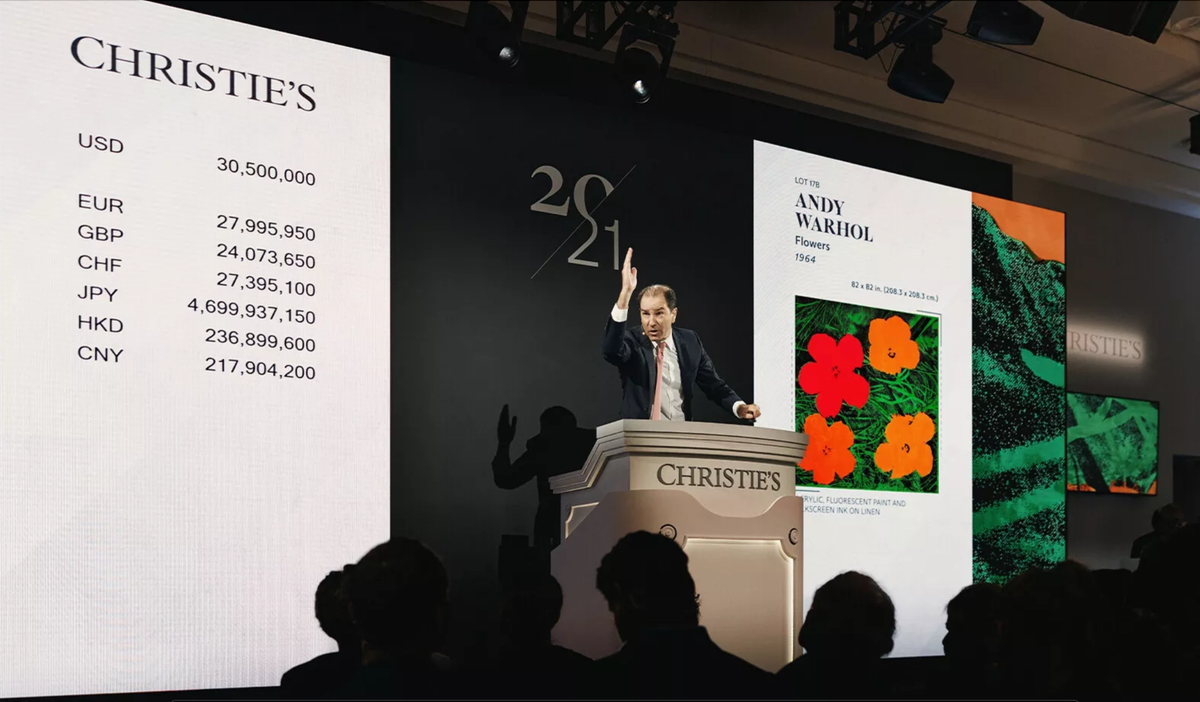“The best is still to come this week,” said Christie’s chief executive, Guillaume Cerutti, at the auction house’s post-sale press conference for its evening auctions on Tuesday (14 May). Last night, Cerutti was proved right, with the house pulling off a reassuringly solid result of $346.5m ($413.3m with fees) from its Modern evening sale—within its pre-sale estimate of $340m-$493.5m (calculated without fees).
This result is made all the more impressive when considering that Christie’s website has been down since last week, due to a still-unexplained cyberattack.
Only three of the sale's 61 lots went unsold, making for a stellar sell-through rate of 95% by lot. A further three were withdrawn, shaving between $5m to $7.5m off the potential total. Of the lots that sold, 25 (or 43% of the sale) came backed by guarantees—24 by third parties and one in house.
Andy Warhol’s massive Flowers (1964), a 208cm by 208cm fluorescent silkscreen, bloomed on the block, and made the evening’s top price of $30.5m ($35.4 with fees), well in excess of its $30m high estimate. It first sold from Leo Castelli Gallery in New York to the major Los Angeles collector Frederick R. Weisman. This was its auction debut.
The overall result easily outran last year’s equivalent various owner sale, which brought $276.1 m ($328.7m with fees). Nonetheless, the evening got off to a sluggish start with Picasso’s masterful, pen and India ink on paper drawing, Femme assise (Dora Maar) from May 1938, featuring his then lover and muse sporting a jaunty hat emblazoned with a fish image. It hammered for $1.2m ($1.5m), well shy of its $1.8m low estimate. It was acquired in 1952 by the famed Chicago collector Morton G. Neumann and sold by his heirs. Another Neumann entry followed: Max Ernst’s Un ami empressé (1957) a 26 ¼ inch-high bronze, which realised $600,000 ($756,000 with fees).
Close attention was paid to a significant pair of Egon Schiele gouache, watercolor and pencil on paper drawings, both from 1911, which came from the recently restituted collection of the Viennese cabaret and film star Fritz Grünbaum, who was murdered by the Nazis at Dachau concentration camp in 1941. Schwarzes Mädchen, a slender female nude in profile, and the larger, more erotic Stehender Akt mit Draperietuch each went for $950,000 ($1.1m with fees). So far, Christie’s has sold nine works from that spoliated collection over a number of sales.
A fresh to market entry—or seemingly so, since the seller has harboured it since acquiring it in 1976 from the dealer Xavier Fourcade—was Willem de Kooning’s evocative Woman on the Dune (1967), executed in oil on paper and mounted on canvas, which made $2.7m ($3.3m with fees). In a class and minimal style of his own making, Robert Ryman’s all-over white abstraction, Untitled (around 1961-63) sold for $9.8m $11.6m (with fees). It came backed by a third party guarantee.
Besides the Warhol top lot, flower power was in strong evidence thanks to Georgia O’Keeffe’s stunning close-up oil painting Red Poppy (1928) that sold to an anonymous phone bidder for $14m ($16.5m with fees). It last sold at auction at the same house back in May 1990 for $1.1m (with fees).
A second Warhol offering, Double Mona Lisa (1963), a black and white silkscreen ink on canvas and a prime example for the artist’s brilliant use of appropriation and repetition, realised $4.6m ($5.6m with fees). According to the entry in the artist’s catalogue raisonne covering the years 1961-63, the sole provenance line for the painting was Thilo von Watzdorf and its present location is “unknown.” That mystery is now solved.
Stellar offerings from the collection of hit television series creators Norman and Lyn Lear included Willem de Kooning’s lusciously surfaced Man in Wainscott (1969) that sold for $7.2m ($8.6m). Topping the Lear trove, David Hockney’s pristine and rhythmic A Lawn Being Sprinkled (1967) and acquired in 1978 from the Los Angeles Louver Gallery fetched $24.5m ($28.5m with fees). When “All in the Family” producer Lear acquired it, he paid $64,000—the highest price at the time for the British-born artist, according to a Christie’s specialist. Pegged today with a $25m-$35m estimate, it was backed by a third party.
Another Los Angeles-associated artist from the Lear collection, Ed Ruscha, also performed well. His fiery hued gold and brown text painting Truth (1973) went to another telephone bidder for a torrid $12.5m ($14.7m with fees), burning past pre-sale expectations of $7m to $10m. The Lear bounty tallied at $50m ($60.1m with fees).
Time travelling into the Impressionist epoch, Claude Monet’s ravishing composition Moulin de Limetz (1888)—one of five works by the artist offered last night—sold for $18.5m ($21.6m with fees). It was deaccessioned by the Nelson-Atkins Museum of Art and the heirs of Ethel B. Atha, the Kansas City collector who acquired it from Knoedler Gallery in New York in 1941. The two-thirds museum portion of the proceeds will benefit future acquisitions. Vincent van Gogh’s hypnotic and closely cropped garden view, Coin de Jardin avec papillons (May-July 1887) sold to yet another telephone bidder for $28.5m ($33.1m with fees). It carried the evening’s highest estimate at $28m to $35 million and also came armed with a third party guarantee.
Alberto Giacometti’s bronze Femme Leoni from a 1958 cast, the third of an edition of six, realised $19m ($22.2m with fees). It last sold at auction at Sotheby’s New York in October 2020 for $28.4m (with fees), meaning last night was likely a disappointment for the consignor. Luckily, the Giacometti also came backed by a third party guarantee.
Indeed, despite reports of a decline in third party guarantees due to diminishing returns in a cooling market, last night reified that this financial tool is still a vital staple for big auction houses amid ongoing unease. And, as it turned out, a critical life support for unexpected events, like if a data breach takes down your website in a marquee auction week.


